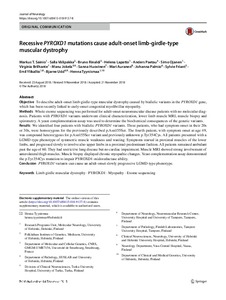Recessive PYROXD1 mutations cause adult-onset limb-girdle-type muscular dystrophy
Markus T. Sainio; Salla Välipakka; Bruno Rinaldi; Helena Lapatto; Anders Paetau; Simo Ojanen; Virginia Brilhante; Manu Jokela; Sanna Huovinen; Mari Auranen; Johanna Palmio; Sylvie Friant; Emil Ylikallio; Bjarne Udd; Henna Tyynismaa
https://urn.fi/URN:NBN:fi-fe2021042821447
Tiivistelmä
Objective: To describe adult-onset limb-girdle-type muscular dystrophy caused by biallelic variants in the PYROXD1 gene, which has been recently linked to early-onset congenital myofibrillar myopathy.
Methods: Whole exome sequencing was performed for adult-onset neuromuscular disease patients with no molecular diagnosis. Patients with PYROXD1 variants underwent clinical characterization, lower limb muscle MRI, muscle biopsy and spirometry. A yeast complementation assay was used to determine the biochemical consequences of the genetic variants.
Results: We identified four patients with biallelic PYROXD1 variants. Three patients, who had symptom onset in their 20s or 30s, were homozygous for the previously described p.Asn155Ser. The fourth patient, with symptom onset at age 49, was compound heterozygous for p.Asn155Ser variant and previously unknown p.Tyr354Cys. All patients presented with a LGMD-type phenotype of symmetric muscle weakness and wasting. Symptoms started in proximal muscles of the lower limbs, and progressed slowly to involve also upper limbs in a proximal-predominant fashion. All patients remained ambulant past the age of 60. They had restrictive lung disease but no cardiac impairment. Muscle MRI showed strong involvement of anterolateral thigh muscles. Muscle biopsy displayed chronic myopathic changes. Yeast complementation assay demonstrated the p.Tyr354Cys mutation to impair PYROXD1 oxidoreductase ability.
Conclusion: PYROXD1 variants can cause an adult-onset slowly progressive LGMD-type phenotype.
Kokoelmat
- Rinnakkaistallenteet [27094]
